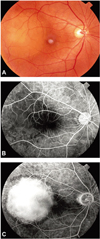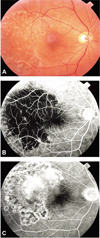Abstract
To report a single case of improvement on choroidal metastasis of breast cancer after laser photocoagulation. A 52-year-old female patient who complained of visual disturbance of the right eye with multiple states of metastasis of breast carcinoma. On initial examination, the right best-corrected visual acuity was 0.63. Right fundoscopy revealed an elevated mass-like lesion temporal to the macule with serous retinal detachment. The mass had a 3.5-disc diameter. A right fluorescein angiogram revealed hypofluorescence during the prearterial and arteriovenous phase and hyperfluorescence during the venous phase. The venous phase showed almost total masking of background choroidal fluorescence at the elevated lesion because of leakage and neovascularization. The patient was treated 4 times by diode laser photocoagulation in addition to chemotherapy. Fifty days after the diode laser treatments, the funduscopy examination and fluorescein angiogram revealed that the serous retinal detachment had been absorbed, the choroid had become flat, the lesion had been reduced in size and hyperfluorescence. The right best-corrected visual acuity was improved to 0.8. Laser photocoagulation appears not to cause any problems for the patient and may be an efficient treatment for patients with choroidal breast carcinoma.
Intraocular metastases are now considered the most common malignancy of the eye and occur in approximately 2% to 7% of patients with cancer. Although any site of the eye can be affected by metastatic disease, the most common tissue involved is the choroid, possibly due to its high vascularization.1 Breast cancer is the most common malignancy to metastasize to the uvea and accounts for 39% to 49% of all uveal metastases.2 Conventionally, the treatment of choroidal metastasis may include radiotherapy, chemotherapy, observation, laser therapy, and surgical intervention. This paper presents a case of diode laser therapeutic regression of choroidal metastasis of breast carcinoma.
A 52-year-old woman sought treatment for decreased visual acuity of 1 month in the right eye. The patient was previously treated with radial mastectomy and chemotherapy 5 years ago for an invasive ductal carcinoma of the right breast. Lung, liver, bone and brain metastases were found 1 year previously. On initial examination, visual acuity with correction was 0.63/0.8 (OD/OS) and intraocular pressure (IOP) was 15/16 mmHg. Right fundoscopy revealed an elevated mass-like lesion at temporal to the macule with serous retinal detachment. The mass had a 3.5-disc diameter. No choroidal lesions were observed in the left fundus.A right fluorescein angiogram revealed hypofluorescence during the prearterial and arteriovenous phase and hyperfluorescence during the venous phase. The venous phase showed nearly complete masking of background choroidal fluorescence at the elevated lesion due to leakage and neovascularization (Fig. 1).
Treatment was started with diode lasers while the patient was undergoing chemotherapy in hematology (gemzar-navelvin 4th, taxotere-cis 3rd). The goal was to achieve white laser marks on the retina. The typical settings were as follows: intensity, 300-400 milliwatts; duration, 0.2 seconds; size, 200-500 microns; 250-300 shot per serial. The patient underwent treatment with a diode laser once a week for a total of 4 weeks.
After 50 days, right funduscopy revealed mass regression in size and height and resolved retinal detachment. Right fluorescein angiogram revealed a flat devascularized choroid, The venous phase showed some leakages from the old lesion that affected the fovea (Fig. 2). Right visual acuity improved with a correction of 0.8.
For one month, the patient preserved the visual function and expired due to cancer emboli.
The various methods for treatment of choroidal metastasis areas follows: observation, radiotherapy, laser photocoagulation, transpupillary thermotherapy, chemotherapy, and enucleation.3 Radiotherapy is the preferred modality for local treatment of an ocular tumor. External beam radiotherapy has been the most commonly used treatment. Although shown to be very effective, 3 to 4 weeks of daily radiation treatment is necessary, which many patients with metastasis find daunting, considering the serious condition of their health.4 Radiotherapy presents a risk for local complications such as cataracts, dry eye syndrome, and radiation retinopathy.3,5 According to Halpern and colleagues,6 chemotherapy alone is effective in approximately one third of the cases. However, systemic therapy has side effects such as gastrointestinal manifestation, fatigue, generalized weakness, neutropenia, or cardiotoxic effects.7
Laser photocoagulation yields a rapid response, is easy to perform on an outpatient basis, and is an effective therapy. Levinger and colleagues,5 treated 10 eyes of 7 patients with krypton red or argon green laser applications for small choroidal breast carcinoma metastasis with serous detachment of the retina. In all eyes, the tumor decreased, the subretinal serous detachment was absorbed, the retina flattened, and the visual acuity improved without complications. The method by which the laser is effective in eradicating choroidal metastases is not clear. According to Levinger and colleagues,5 the effectiveness of the laser treatment was not a result of occlusion of the retinal or choroidal blood circulation. A possible explanation for the mode of laser action is the destruction of the vasculature of the tumor. In other words, the laser closes all the blood vessels of the tumor, causing the tumor cells to die. Glaser and colleagues8,9 suggested that laser treatment may effect the retina and choroid through the release of extracellular modulating factors by laser-induced chorioretinal scars including neovascularization inhibiting factors. If this theory is correct, the laser may induce destruction of the metastatic tumor by inhibition of the tumor angiogenesis, and formation of ischemia.5
In this study, diode laser photocoagulation was selected because the patient's physical condition was poor and the laser procedure was short. Consequently, the mass regressed, subretinal serous detachment was absorbed, and the visual acuity improved. Laser photocoagulation does not appear to cause complications for the patient and may be an effective treatment for patients with choroidal metastasis of breast carcinoma.
Figures and Tables
 | Fig. 1(A) Right fundoscopy revealed an elevated mass-like lesion temporal to the macule with serous retinal detachment. The mass had a 3.5-disc diameter. (B) A right fluorescein angiogram revealed hypofluorescence during the prearterial and arteriovenous phase and hyperfluorescence during the venous phase. (C) A right fluorescein angiogram revealed hypofluorescence duringthe venous phase showing a nearly complete masking of background choroidal fluorescence at the elevated lesion due to leakage and neovascularization. |
References
1. Mejía-Novelo A, Alvarado-Miranda A, Morales-Vázquez F, et al. Ocular metastases from breast carcinoma. Med Oncol. 2004. 21:217–221.
2. Demirci H, Shields CL, Chao AN, Shields JA. Uveal mertastasis from breast cancer in 264 patients. Am J Ophthalmol. 2003. 136:264–271.
3. Kim US, Yu SY, Kim SW, Kwak HW. Five case of transpupillary thermotherapy for intraocular tumors. J Korean Ophthalmol Soc. 2003. 44:2942–2991.
4. Tsina EK, Lane AM, Zacks DN, et al. Treatment of metastatic tumors of the choroid with proton beam irradiation. Ophthalmology. 2005. 112:337–343.
5. Levinger S, Merin S, Seigal R, Pe'er J. Laser therapy in the management of choroidal breast tumor metastases. Ophthalmic Surg Lasers. 2001. 32:294–299.
6. Halpern J, Sofinski SJ, Forgach PW, et al. Choroidal metastases arising from carcinoma of the breast. Review and analysis of the five cases. J Med. 1986. 17:1–11.
7. Amer R, Pe'er J, Chowers I, Anteby I. Treatment options in the management of choroidal metastases. Ophthalmologica. 2004. 218:372–377.
8. Glaser BM, Campochiaro PA, Davis JL Jr, Sato M. Retinal pigment epithelial cells release an inhibitor of neovascularization. Birth Defects Orig Artic Ser. 1988. 24:121–127.
9. Glaser BM. Extracellular modulationg factors and the control of intraocular neovascularization. Arch Ophthalmol. 1988. 106:603–607.




 PDF
PDF ePub
ePub Citation
Citation Print
Print



 XML Download
XML Download